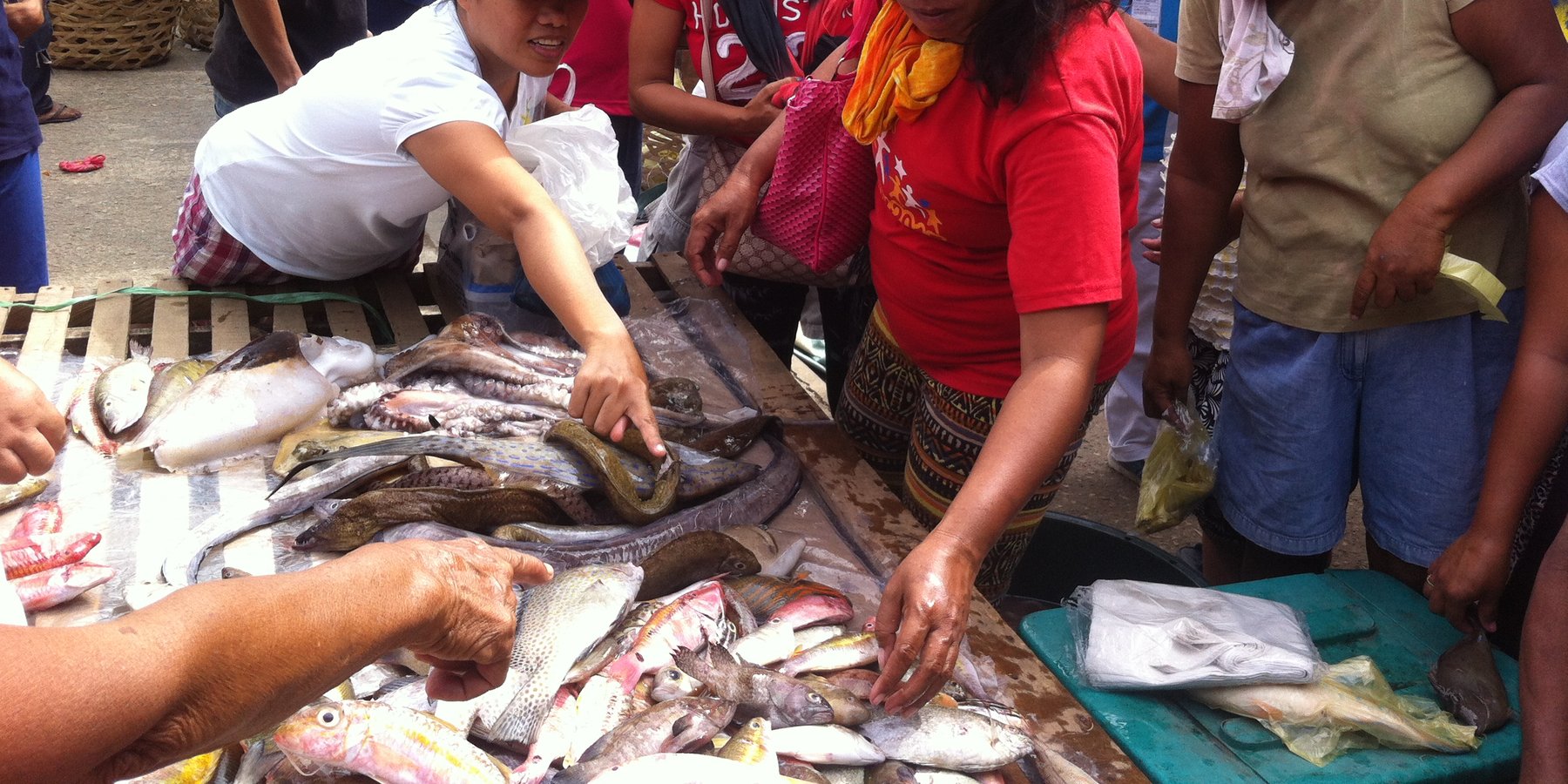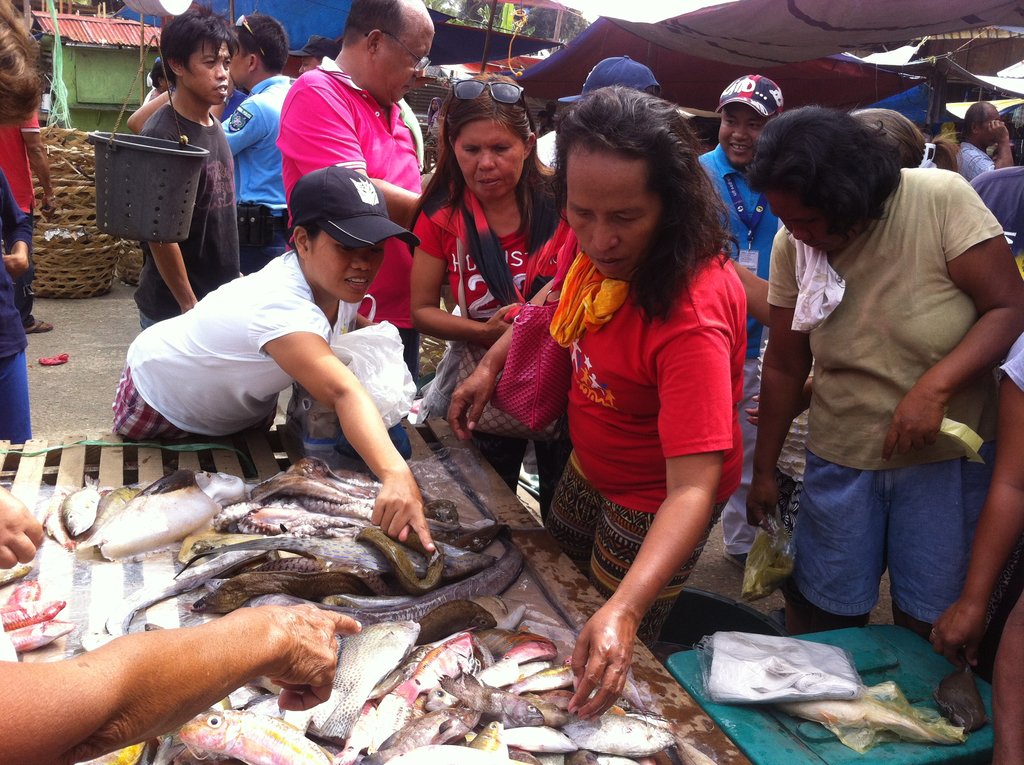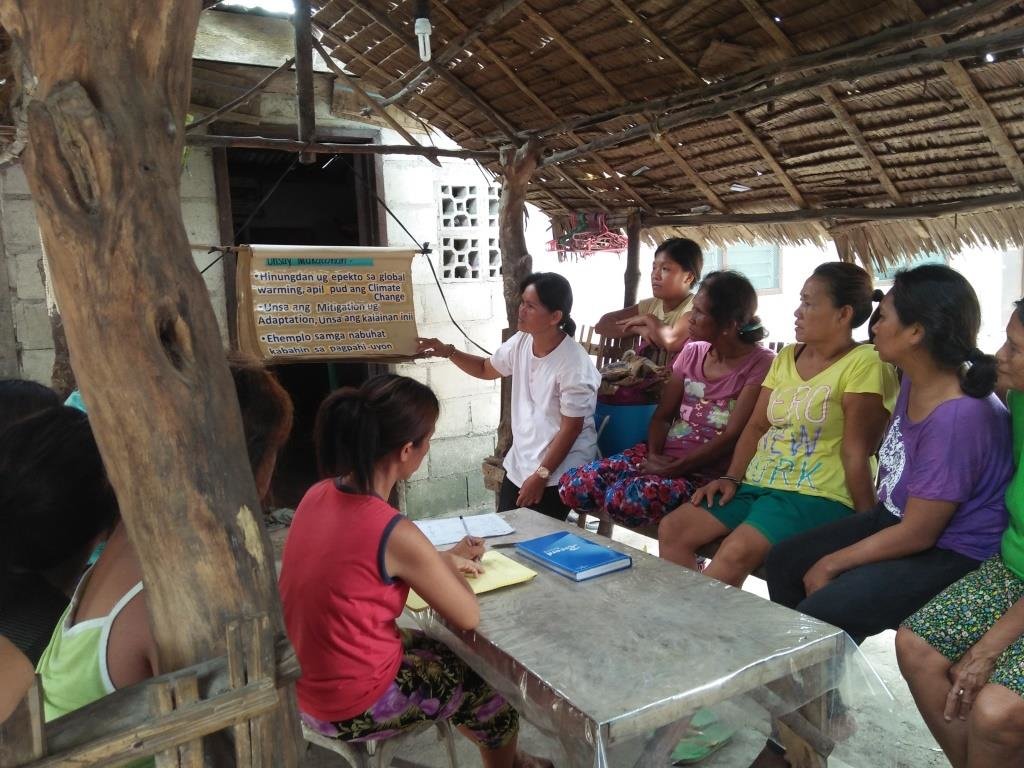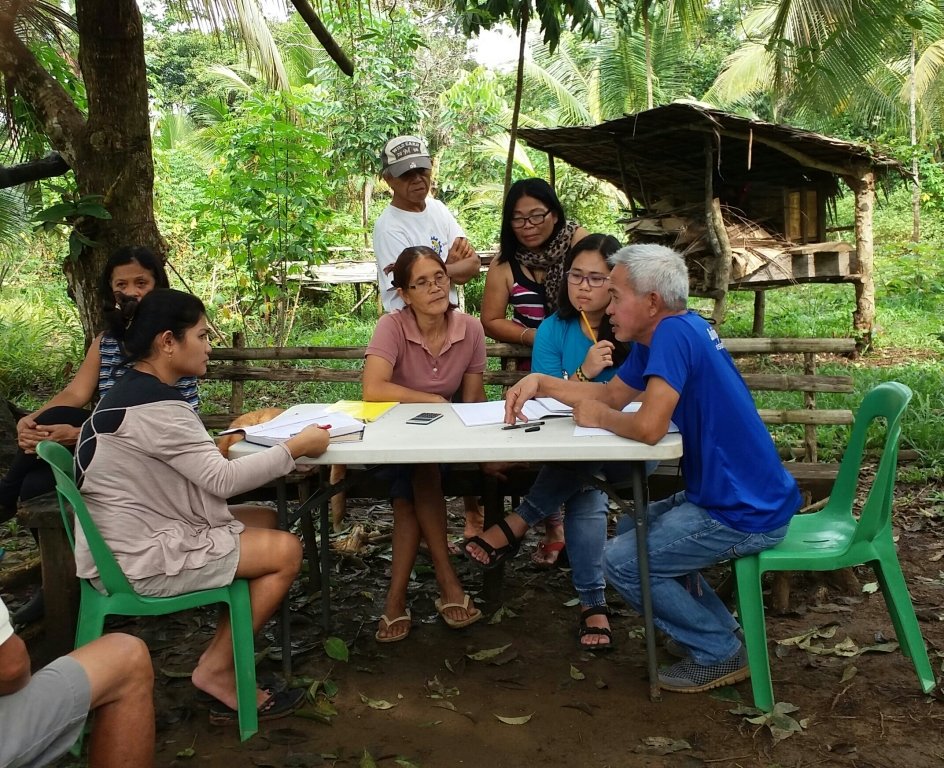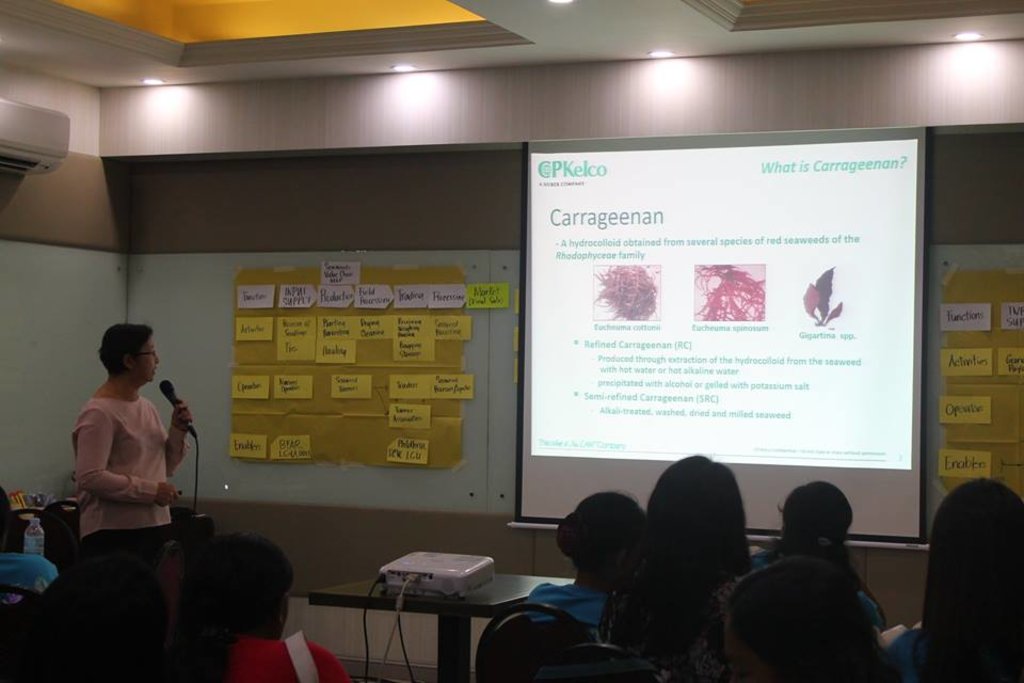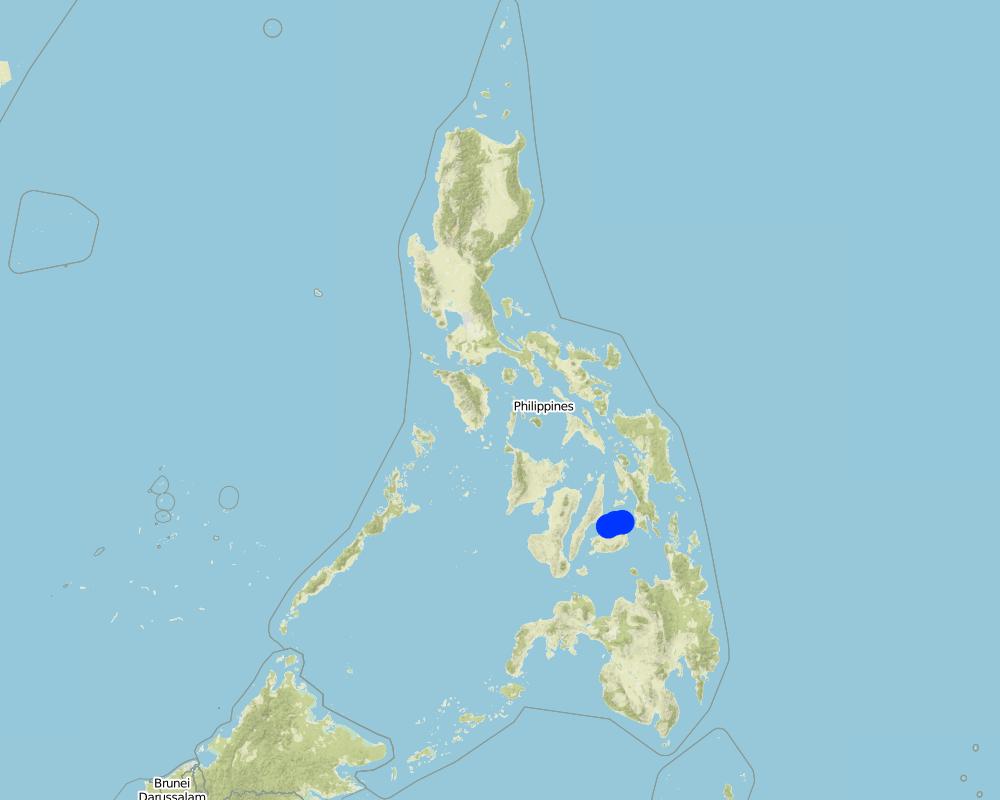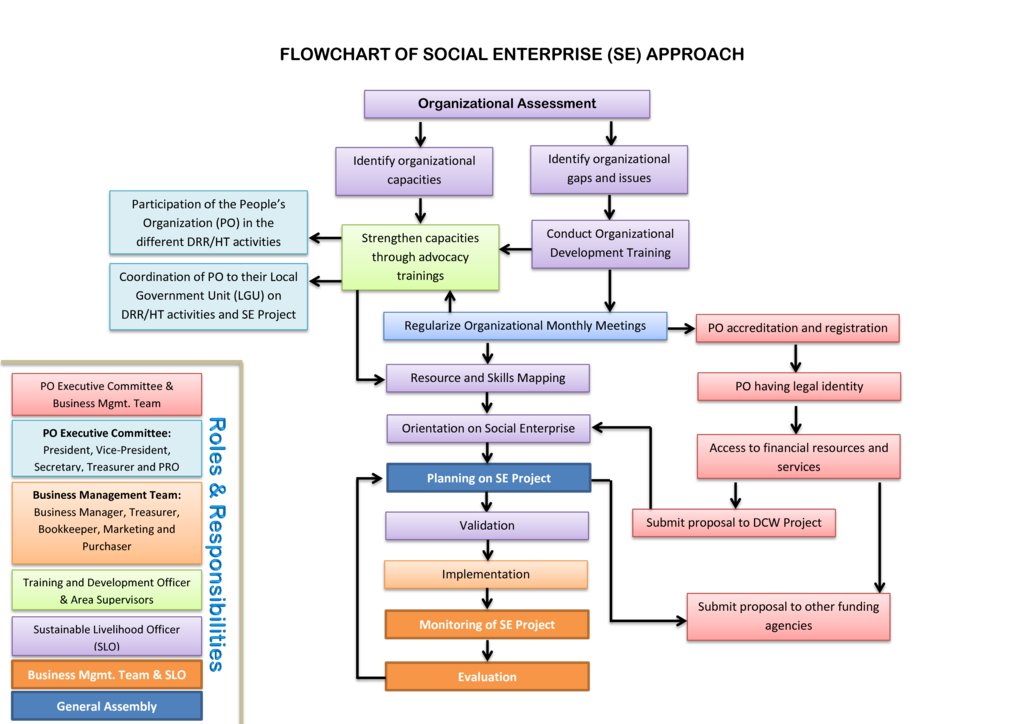Social Enterprise (SE) [ฟิลิปปินส์]
- ผู้สร้างสรรค์:
- การอัพเดท:
- ผู้รวบรวม: Keeshia Lynn Marie Austria
- ผู้เรียบเรียง: –
- ผู้ตรวจสอบ: Alexandra Gavilano
Katilingbanong Patigayon
approaches_3119 - ฟิลิปปินส์
ดูส่วนย่อย
ขยายทั้งหมด ย่อทั้งหมด1. ข้อมูลทั่วไป
1.2 รายละเอียดที่ติดต่อได้ของผู้รวบรวมและองค์กรที่เกี่ยวข้องในการประเมินและการจัดเตรียมทำเอกสารของแนวทาง
วิทยากรหลัก
Sustainable Livelihood Officer (SLO):
ฟิลิปปินส์
ชื่อของโครงการซึ่งอำนวยความสะดวกในการทำเอกสารหรือการประเมินแนวทาง (ถ้าเกี่ยวข้อง)
Danajon Communities WATCH ( DCW)ชื่อของโครงการซึ่งอำนวยความสะดวกในการทำเอกสารหรือการประเมินแนวทาง (ถ้าเกี่ยวข้อง)
Philippine Partnership for the Development of Human Resoruces in Rural Areasy (PhilDHRRA) - ฟิลิปปินส์1.3 เงื่อนไขที่เกี่ยวข้องกับการใช้ข้อมูลที่ได้บันทึกไว้ผ่านทาง WOCAT
วันที่เก็บรวบรวมข้อมูล (ภาคสนาม):
04/04/2017
ผู้รวบรวมและวิทยากรหลักยอมรับเงื่อนไขเกี่ยวกับการใช้ข้อมูลที่ถูกบันทึกผ่านทาง WOCAT:
ใช่
1.4 การอ้างอิงถึงแบบสอบถามเรื่องเทคโนโลยี SLM
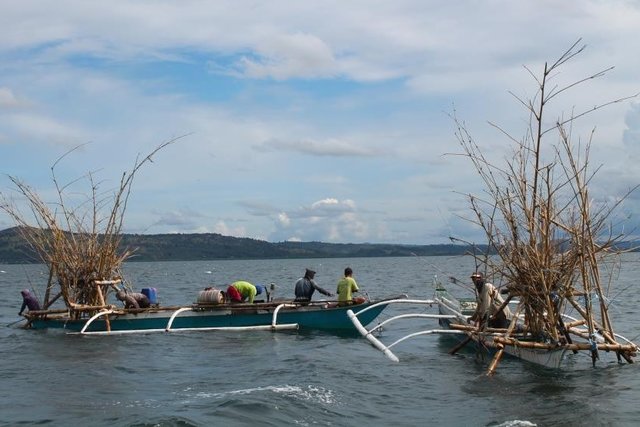
Artificial Reef [ฟิลิปปินส์]
Artificial Reef is a fish aggregating device that is considered as a sustainable alternative in the islands of Bohol. This technology can withstand the effects of gale warning, typhoons and extreme heat.
- ผู้รวบรวม: Keeshia Lynn Marie Austria
2. คำอธิบายของแนวทาง SLM
2.1 การอธิบายแบบสั้น ๆ ของแนวทาง
Social Enterprise (SE) aimed to provide social protection among its members and generate additional family income. Above all, this approach will encourage the conservation, preservation and protection of the resources available in the community.
2.2 การอธิบายอย่างละเอียดของแนวทาง
การอธิบายอย่างละเอียดของแนวทาง:
Social Enterprise (SE) materialized because of the experiential processes conducted by the Sustainable Livelihood Officer. According to him, livelihood intervention should achieve the advocacy of the project, at the same time, relevant and suitable to the people living in the island and coastal communities. SE Approach was a result of the focus group discussions conducted in the community and livelihood consultations of the different stakeholders in the barangay level. According to the Local Government Code of the Philippines, Book III, Section 386 (a), A Barangay maybe created out of a contiguous territory which has a population of at least two thousand (2,000) inhabitants as certified by the National Statistics Office. Furthermore, Section 386 states that barangay is the basic political unit. It serves as the primary planning and implementing unit of government policies, plans, programs, projects, and
activities in the community, and as a forum wherein the collective views of the people may be expressed, crystallized and considered, and where disputes may be amicably settled.
Social Enterprise Project was determined using the following methods: resource mapping, identification of social enterprise project, planning and preparation which includes community equity fund, implementation, maintenance and monitoring, lastly, expansion and/or diversification of the implemented project. Once the enterprise is established, the organization will elect the members of their business management team. This is different from the set of officers typically present in every organization because business management team will focus on the business engagements only. The business management team is headed by the business manger, who will report directly to the president of the organization. The members of the team includes the following: treasurer, bookkeeper, purchaser and marketing team (if needed by the enterprise project).
The management team will receive 20% of the net income. Afterwards, the remaining net income will be divided according to the following percentage: 10% for disaster fund allocation, 10-20% for additional capital, and the remaining amount is allocated for individual member share. SE does not only focus on net profit but also the welfare of the community, its resources and social protection among its members. Social protection specifically means having disaster fund allocation per organization which is derived from the net income of the enterprise. This fund can be utilized by the organization before or after the onset of a disaster, depending on their agreed utilization guidelines. The sustainability components are the following: allocation for additional capital, depreciation cost for every equipment and experiential mentoring of the Livelihood Officer.
Based from the baseline study of DCW Project, Human Trafficking cases increased after a disaster. DCW project aimed to build resilient communities in order to combat Human Trafficking, however, conducting awareness sessions, coordination meetings with the local government unit and establishing HT referral system is not enough to prevent Human Trafficking. On the second year of the project, the project management team realized that livelihood component is the missing link in fighting against Human Trafficking. The body agreed that sustainable livelihood project means being adaptable and resilient to climate change. For the livelihood officer, group enterprise is an important mechanism in promoting adaptable and resilient livelihood project. This approach was granted to the People's Organization (PO) in the barangays who were organized or adopted by DCW project.
Due to the awareness sessions conducted, the organizations were motivated to join the advocacy activities like coastal clean-up and mangrove planting. They were also invited to join forums on the Solid Waste Management (SWM), referral pathway on Human Trafficking (HT) and awareness training on the causes and effects of Climate Change and sea level rise, since they are living in the island and coastal barangays. PO organizations serve as community partners of DCW project in facilitating learning sessions in the different barangays. Furthermore, DCW project provided inputs how to make their enterprise resilient and sustainable by being adaptive to the changing weather especially those organizations living in the island barangays.
2.3 รูปภาพของแนวทาง
2.5 ประเทศ ภูมิภาค หรือสถานที่ตั้งที่ได้นำแนวทางไปใช้
ประเทศ:
ฟิลิปปินส์
ภูมิภาค/รัฐ/จังหวัด: :
Province of Bohol
Map
×2.6 วันที่เริ่มต้นและสิ้นสุดของแนวทาง
ระบุปีที่เริ่ม:
2016
ถ้าไม่รู้ปีที่แน่นอนให้ประมาณวันที่ที่ริเริ่มใช้แนวทางนี้ :
น้อยกว่า 10 ปี (เร็วๆนี้)
ความคิดเห็น:
The Social Enterprise project of the different organizations are currently ongoing.
2.7 ประเภทของแนวทาง
- ใช้โครงงานหรือแผนงานเป็นฐาน
2.8 เป้าหมายหรือวัตถุประสงค์หลักของแนวทาง
Social Enterprise (SE) aimed to provide social protection among its members and generate additional family income. Above all, this approach will encourage the conservation, preservation and protection of the resources available in the community.
2.9 เงื่อนไขที่เอื้ออำนวยหรือเป็นอุปสรรคต่อการนำเทคโนโลยีภายใต้แนวทางนี้ไปปฏิบัติใช้
บรรทัดฐานและค่านิยมทางสังคม วัฒนธรรม ศาสนา
- เอื้ออำนวย
Membership of the organization encouraged multi stakeholder participation.
การมีไว้ให้หรือการเข้าถึงแหล่งการเงินและบริการ
- เอื้ออำนวย
The People's Organization (PO) can easily access financial resources and services if they were already established and registered by the different government agencies. One of the determinants of the capability of the PO is having annual financial statement, minutes of the organizational meetings and resolutions made by the organization.
- เป็นอุปสรรค
Having a weak or inactive People's Organization. If the PO does not comply the necessary requirements of the different government agencies and inactive in the different organizational activities, then, they will have difficulty in accessing funds.
การจัดตั้งระดับองค์กร
- เอื้ออำนวย
It will facilitate to address the needs of the organization like capacity building, technical assistance and financial support.
- เป็นอุปสรรค
The bureaucratic procedures and priorities of every institution.
การร่วมมือหรือการทำงานประสานกันของผู้ลงมือปฏิบัติ
- เอื้ออำนวย
It will make the decision-making process participatory and according to the needs of the majority.
กรอบแนวทางในการดำเนินการด้านกฎหมาย (การถือครองที่ดิน สิทธิในการใช้ที่ดินและน้ำ)
- เอื้ออำนวย
This approach specifically refers to Coastal Resource Management (CRM). The project implementer, People's Organization (PO) and the CRM officer already had partnership. Moreover, the PO representative is one of the members of CRM council to ensure legal identity of the Social Enterprise projects.
นโยบาย
- เอื้ออำนวย
It will give directions and set the standards of the organization.
- เป็นอุปสรรค
If the policies mandated were not agreed by the majority.
ตลาด (จัดซื้อปัจจัยนำเข้า ขายผลิตภัณฑ์) และราคา
- เอื้ออำนวย
The People's Organization (PO) already established linkage to the different markets.
- เป็นอุปสรรค
The quality of product expected by the buyers is not met by the People's Organization.
ปริมาณงานที่ทำได้ กำลังคนที่มีให้
- เอื้ออำนวย
DCW Project provided Social Enterprise (SE) guidelines for business operation, financial management and monitoring of enterprise.
3. การมีส่วนร่วมและบทบาทของผู้มีส่วนได้ส่วนเสียที่เกี่ยวข้อง
3.1 ผู้มีส่วนได้ส่วนเสียที่เกี่ยวข้องในแนวทางนี้และบทบาท
- องค์กรที่ขึ้นอยู่กับชุมชน
People's Organization
The implementer and beneficiary of the project.
- ผู้เชี่ยวชาญ SLM หรือที่ปรึกษาการเกษตร
Sustainable Livelihood Officer: Male, 59 years old
Facilitates the implementation of the SE projects and provides technical assistance to the PO and project staff.
- รัฐบาลระดับท้องถิ่น
Municipal and barangay local government unit
Support system through legislation and resolution that adheres the needs of the PO.
3.2 การเกี่ยวข้องของผู้ใช้ที่ดินระดับท้องถิ่นหรือชุมชนระดับท้องถิ่นในช่วงต่างๆของแนวทาง
| ความเกี่ยวข้องของผู้ใช้ที่ดินระดับท้องถิ่นหรือชุมชนระดับท้องถิ่น | ระบุผู้ที่มีส่วนเกี่ยวข้องและอธิบายกิจกรรม | |
|---|---|---|
| การริเริ่มหรือการจูงใจ | ปฏิสัมพันธ์ | PO members, Sustainable Livelihood Officer, Field Officers, Area Supervisors and representative of the barangay council. Activity: FGD, resource mapping, consultations and assessment of the organizations capability in handling social enterprise project. |
| การวางแผน | ปฏิสัมพันธ์ | PO members, Sustainable Livelihood Officer, Field Officers, Area Supervisors and representative of the barangay council |
| การดำเนินการ | ระดมกำลังด้วยตนเอง | PO members, Sustainable Livelihood Officer, Field Officers and Area Supervisors |
| การติดตามตรวจสอบหรือการประเมินผล | ระดมกำลังด้วยตนเอง | PO members, Sustainable Livelihood Officer and Field Officers |
3.3 แผนผังแสดงขั้นตอนการทำงาน (ถ้ามี)
คำอธิบาย:
Capacity building on Disaster Risk Reduction (DRR) and Human Trafficking (HT) is integrated in this approach so that PO members will have greater appreciation on the preservation, conservation and protection goal of SE approach. The Sustainable Livelihood Officer (SLO) served as facilitator and guide of the PO in strengthening their organization and implementing their enterprise. He will also provide technical assistance, conduct coaching and mentoring sessions within the project term. Frequency of monitoring will depend on the nature of their SE project.
ผู้เขียน:
Guillermo P. Bagacay
3.4 การตัดสินใจเลือกใช้เทคโนโลยี SLM
ระบุผู้ที่ทำการตัดสินใจเลือกเทคโนโลยีมากกว่าหนึ่งวิธีไปปฏิบัติใช้:
- ผู้ลงมือปฏิบัติที่เกี่ยวข้องทั้งหมดในฐานะที่เป็นส่วนรวมของแนวทาง
การอธิบาย:
Focus Group Discussion (FGD) and livelihood consultations in the barangay level were conducted by the livelihood officer in order to achieve a feasible and suitable Social Enterprise project specific for their community. After leveling off and the exchange of ideas based from their previous experience vis-a-vi the current trend of the weather patterns and climate change, the organization finally arrived to a conclusion and implement their desired social enterprise project.
ระบุว่าการตัดสินใจตั้งอยู่บนพื้นฐานของ:
- ประสบการณ์และความคิดเห็นส่วนตัว (ไม่ได้ลงบันทึกไว้)
4. การสนับสนุนด้านเทคนิค การสร้างขีดความสามารถ และการจัดการด้านความรู้
4.1 การสร้างขีดความสามารถ / การอบรม
ได้มีการจัดอบรมให้แก่ผู้ใช้ที่ดินหรือผู้มีส่วนได้ส่วนเสียคนอื่น ๆ หรือไม่:
ใช่
ให้ระบุว่าใครเป็นผู้ได้รับการอบรม:
- ผู้ใช้ที่ดิน
รูปแบบการอบรม:
- ใช้พื้นที่ทำการสาธิต
รูปแบบการอบรม:
- On-site coaching and mentoring
หัวข้อที่พูด:
1) Technical Assistance in drafting proposals and lobbying
2) Financial Recording and Bookkeeping
3) Value Chain Analysis
4) Enterprise Development
5) Occupational Health and Health Standards
4.2 การบริการให้คำแนะนำ
ผู้ใช้ที่ดินมีการเข้าถึงการรับบริการให้คำปรึกษาหรือไม่:
ใช่
ระบุว่ามีบริการให้คำปรึกษาหรือไม่:
- ไปเยี่ยมชมสถานที่
4.3 การเสริมความแข็งแกร่งให้กับสถาบัน (การพัฒนาองค์กร)
สถาบันได้รับการจัดตั้งขึ้นมาหรือเสริมความแข็งแกร่งโดยแนวทางนี้หรือไม่:
- ใช่ ปานกลาง
ระบุระดับของสถาบันที่ได้รับการเสริมความแข็งแกร่งหรือจัดตั้งขึ้นมา:
- ท้องถิ่น
อธิบายถึงสถาบัน บทบาทและความรับผิดชอบ สมาชิก เป็นต้น:
Some of the members of the organization are capacitated to become local champions. Local champions means they have the ability to facilitate learning sessions, actively involved in organizational activities and empowered enough to link and lobby with the different line agencies. While the leaders of the organization are trained to manage their organizations and social enterprise.
ระบุประเภทของการให้ความช่วยเหลือสนับสนุน:
- ด้านการเงิน
- การสร้างขีดความสามารถ / การอบรม
- Seed Capital worth Php30,000
4.4 การติดตามตรวจสอบและประเมินผล
การติดตามตรวจสอบและประเมินผลเป็นส่วนหนึ่งของแนวทางหรือไม่:
ใช่
ถ้าตอบว่าใช่ แสดงว่าการจัดเตรียมเอกสารนี้มุ่งหวังที่จะเอาไปใช้สำหรับการติดตามตรวจสอบและประเมินผลใช่หรือไม่:
ไม่ใช่
4.5 การวิจัย
การวิจัยเป็นส่วนหนึ่งของแนวทางหรือไม่:
ไม่ใช่
5. การสนับสนุนด้านการเงินและวัสดุอุปกรณ์
5.1 ระบุงบประมาณประจำปีสำหรับแนวทาง SLM นี้
ถ้าหากว่างบประมาณประจำปีไม่เป็นที่ทราบแน่นอน ให้ระบุช่วงลงไป:
- 2,000-10,000
แสดงความคิดเห็น (แหล่งของการระดมทุน ผู้บริจาคคนสำคัญ):
DCW Project is funded by Caritas Switzerland and JTIF
5.2 การสนับสนุนด้านการเงิน / วัสดุอุปกรณ์ให้แก่ผู้ใช้ที่ดิน
ผู้ใช้ที่ดินได้รับการสนับสนุนด้านการเงิน / วัสดุอุปกรณ์ไปปฏิบัติใช้เทคโนโลยีหรือไม่:
ไม่ใช่
5.3 เงินสนับสนุนสำหรับปัจจัยนำเข้า (รวมถึงแรงงาน)
- ไม่มี
ถ้าแรงงานโดยผู้ใช้ที่ดินเป็นปัจจัยนำเข้าที่มีอยู่มากมาย ระบุด้วยว่าเนื่องจาก:
- สมัครใจ
5.4 เครดิต
มีการจัดหาเครดิตมาให้ภายใต้แนวทาง SLM หรือไม่:
ไม่ใช่
5.5 แรงจูงใจหรือเครื่องมืออื่น ๆ
แรงจูงใจหรือเครื่องมืออื่น ๆ ได้ถูกนำไปใช้ส่งเสริมการใช้เทคโนโลยี SLM หรือไม่:
ไม่ใช่
6. การวิเคราะห์ผลกระทบและการสรุป
6.1 ผลกระทบของแนวทาง
ทำให้ผู้ใช้ที่ดินระดับท้องถิ่นมีอำนาจขึ้น ปรับปรุงการเข้าร่วมของผู้มีส่วนได้ส่วนเสียให้ดีขึ้นหรือไม่:
- ไม่ใช่
- ใช่ เล็กน้อย
- ใช่ ปานกลาง
- ใช่ อย่างมาก
SE approach integrates the lesson learned from their experience during Typhoon Haiyan and Bohol earthquake and sustainability measures of the community. This approach is localized to ensure that the project is suitable and adaptable to their respective communities.
ช่วยในการตัดสินใจโดยดูจากหลักฐาน ได้หรือไม่:
- ไม่ใช่
- ใช่ เล็กน้อย
- ใช่ ปานกลาง
- ใช่ อย่างมาก
Yes because the planning process was represented by the different stakeholders in the barangay.
ช่วยให้ผู้ใช้ที่ดินนำเอาเทคโนโลยี SLMไปใช้และบำรุงรักษาสภาพไว้ได้หรือไม่:
- ไม่ใช่
- ใช่ เล็กน้อย
- ใช่ ปานกลาง
- ใช่ อย่างมาก
Yes because the approach serves as guide from planning to implementation and monitoring of the project.
ปรับปรุงความรู้และความสามารถของผู้ใช้ที่ดินในการดำเนินการ SLM หรือไม่:
- ไม่ใช่
- ใช่ เล็กน้อย
- ใช่ ปานกลาง
- ใช่ อย่างมาก
Yes because the PO members are now financial literate and underwent series of financial coaching and mentoring sessions.
ทำให้กลุ่มด้อยโอกาสมีอำนาจทางสังคมและเศรษฐกิจหรือไม่:
- ไม่ใช่
- ใช่ เล็กน้อย
- ใช่ ปานกลาง
- ใช่ อย่างมาก
Yes because the women, senior citizens and persons with disability are members of the organization.
ปรับปรุงความทัดเทียมกันด้านเพศและให้อำนาจแก่ผู้หญิงและเด็กผู้หญิงหรือไม่:
- ไม่ใช่
- ใช่ เล็กน้อย
- ใช่ ปานกลาง
- ใช่ อย่างมาก
Yes because every member has their shared efforts.
trainings provided and linkage to different government agencies
ปรับปรุงความสามารถของผู้ใช้ที่ดินในการปรับตัวให้เข้ากับการเปลี่ยนแปลงของสภาพภูมิอากาศหรือสภาพที่รุนแรงและภัยพิบัติหรือไม่:
- ไม่ใช่
- ใช่ เล็กน้อย
- ใช่ ปานกลาง
- ใช่ อย่างมาก
It is because the goal of the approach is to establish sustainable social enterprise that can adapt to climate change especially that they are living in the island and coastal barangays of Bohol, Philippines.
นำไปสู่โอกาสในการจ้างงาน รายได้หรือไม่:
- ไม่ใช่
- ใช่ เล็กน้อย
- ใช่ ปานกลาง
- ใช่ อย่างมาก
Resource-based projects needs additional manpower during harvest.
6.2 แรงจูงใจหลักของผู้ใช้ที่ดินเพื่อที่จะนำ SLM ไปปฏิบัติใช้
- การผลิตที่เพิ่มขึ้น
Establish resilient and suitable enterprise in their respective communities.
- ความเสี่ยงของภัยพิบัติลดลง
By means of allocating disaster funds and adaptability measures of the enterprise as part of its sustainability plan.
- ความรู้และทักษะ SLM ที่เพิ่มพูนขึ้น
This is a livelihood approach that does not just focus on profit but also on social awareness and climate change adaptation.
6.3 ความยั่งยืนของกิจกรรมของแนวทาง
ผู้ใช้ที่ดินสามารถทำให้สิ่งต่างๆ ที่ได้ปฏิบัติใช้โดยแนวทางนี้ยั่งยืนได้หรือไม่ (โดยไม่มีการสนับสนุนจากภายนอก):
- ไม่แน่ใจ
ถ้าตอบว่าไม่หรือไม่แน่ใจ ให้ระบุและแสดงความคิดเห็น :
Because the dynamics within the organization is a vital factor in sustainability. The role of a second liner of the key positions and business management team is crucial as well since they are involve in the technical support and business processes.
6.4 จุดแข็งและข้อได้เปรียบของแนวทาง
| จุดแข็ง / ข้อได้เปรียบของแนวทางในทัศนคติของผู้ใช้ที่ดิน |
|---|
| This is not an individualistic approach but a group effort in order to revive the "bayanihan" spirit (spirit of communal unity, work and cooperation to achieve a particular goal) and social awareness. |
| The People's Organization (PO) members underwent training like financial management, Value Chain Analysis (VCA), Occupational Safety and Health Standards (OSHS). What made this approach different from their previous livelihood projects is that, the PO were guided from planning to implementation and monitored on a monthly basis to ensure the continuity of their business engagement. Also, there were mentoring and coaching sessions provided by the livelihood officer and consultant on financial recording and bookkeeping. |
| The PO learned that it is not only about the quality of output, rather, the quality starting from its source to production and marketing. Moreover, its impact on their environment and community. |
| จุดแข็ง / ข้อได้เปรียบของแนวทางในทัศนคติของผู้รวบรวมหรือวิทยากรหลัก |
|---|
| This approach will not only focus on profit but also on environmental protection, conservation and preservation. |
| Increase fish production because it will lessen the pressure of their usual fishing ground and minimize over fishing. |
| Alternative source of income to the fishers especially if there's gale warning and typhoons. |
6.5 จุดอ่อน / ข้อเสียเปรียบของแนวทางและวิธีในการแก้ไข
| จุดอ่อน / ข้อเสียเปรียบในทัศนคติของผู้ใช้ที่ดิน | สามารถแก้ไขปัญหาได้อย่างไร |
|---|---|
| Turn over of Business Management Team especially the bookkeeper position because it is time demanding and keen on details. |
Choose a bookkeeper that is willing enough to follow through the records and no problem on his/her eye sight. Encourage and train second liner on the key positions. Provide honorarium to the business management team. |
| Security of tenure (land/sea) of their project site or production building. |
To enter a Memoramdum of Agreement (MOA) between the local government units. Lobbying in the local government unit to pass a resolution allowing the PO to use the land/sea as project site or production building. |
| Sustainability of the project even after DCW. |
The project holder will enter a Memorandum of Agreement (MOA) between the local government unit as partners of the community in sustaining their project. Provided technical skills training to the PO so that they can mange their enterprise even after DCW project. Ensure registration and accreditation of the POs in the different committees of the local government unit and different government agencies. |
| จุดอ่อน / ข้อเสียเปรียบในทัศนคติของผู้รวบรวมหรือวิทยากรหลัก | สามารถแก้ไขปัญหาได้อย่างไร |
|---|---|
| 2 years and 9 months is not enough to mold a strong and dynamic community-based social enterprise. | Linkage to the Local Government Unit (LGU) and the different line agencies like Department of Trade and Industries (DTI), Bureau of Fisheries and Aquatic Resources (BFAR) and Department of Science and Technology (DOST). |
| Upgrading of the People's Organization (PO) knowledge on production technology, marketing and product packaging. | Linkage to the different line agencies like Department of Trade and Industries (DTI), Bureau of Fisheries and Aquatic Resources (BFAR) and Department of Science and Technology (DOST) because they have the expertise to support the needs of the PO. For example, DTI for marketing and linkage and DOST for product development. |
| Capacity to access funds from the different line agencies and fund donors. | Train the PO to conceptualize a project based from their needs, write project proposals and submit it to the concern agencies for funding. |
7. การอ้างอิงและการเชื่อมต่อ
7.1 วิธีการหรือแหล่งข้อมูล
- ไปเยี่ยมชมภาคสนาม การสำรวจพื้นที่ภาคสนาม
along with monthly monitoring visits and Occupational Safety and Health Standards (OSHS)
- การสัมภาษณ์กับผู้ใช้ที่ดิน
two respondent per organization
ลิงก์และโมดูล
ขยายทั้งหมด ย่อทั้งหมดลิงก์

Artificial Reef [ฟิลิปปินส์]
Artificial Reef is a fish aggregating device that is considered as a sustainable alternative in the islands of Bohol. This technology can withstand the effects of gale warning, typhoons and extreme heat.
- ผู้รวบรวม: Keeshia Lynn Marie Austria
โมดูล
ไม่มีโมดูล


